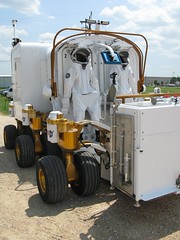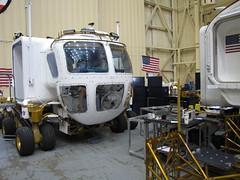 Dry runs are a critical aspect of any Desert RATS analog field test. After the objectives of this years field test were established, each team went to work on their aspect of the project. Engineers created solutions such as PUP, the Portable Utility Pallet. This device has stowage space, geological evaluation tools, and even a wireless mesh network repeater. As the field test approaches, each subsytem needs to be fully tested and evaluated. Sometimes this is as simple as a functionality test, however it can expand into finding ways to improve durability, usability, and even things such as ergonomics.
Dry runs are a critical aspect of any Desert RATS analog field test. After the objectives of this years field test were established, each team went to work on their aspect of the project. Engineers created solutions such as PUP, the Portable Utility Pallet. This device has stowage space, geological evaluation tools, and even a wireless mesh network repeater. As the field test approaches, each subsytem needs to be fully tested and evaluated. Sometimes this is as simple as a functionality test, however it can expand into finding ways to improve durability, usability, and even things such as ergonomics. Changes have also been made based on lessons learned from previous outings. The new automated suit ports will simplify exiting LER. Software such as the navigation system have been overhauled for ease of use and increased functionality.
In the end the goal is a successful analog field test. This goal can only be met by insuring each subsystem has been integrated and tested. Desert RATS is about working together to achieve a goal that is unreachable independent of each other. Valuable lessons are learned here on Earth so that these systems are ready for the missions of the future. The Desert RATS is a NASA-led team of research partners working together to prepare for human-robotic exploration. This “working group,” led by NASA personnel, is comprised of both NASA and non-NASA Members.
The Desert RATS is a NASA-led team of research partners working together to prepare for human-robotic exploration. This “working group,” led by NASA personnel, is comprised of both NASA and non-NASA Members.
The Desert RATS field test activity is the culmination of the various individual science and advanced engineering discipline areas year-long technology and operations development efforts into a coordinated field test demonstration under representative (analog) planetary surface terrain conditions. The purpose of the RATS effort is to drive out preliminary exploration operational concepts for EVA system requirements by providing hands-on experience with simulated planetary surface exploration extravehicular activity (EVA) hardware and procedures.
